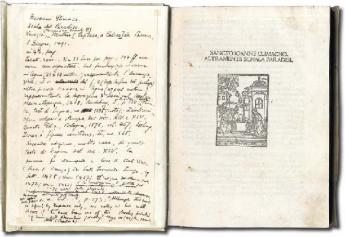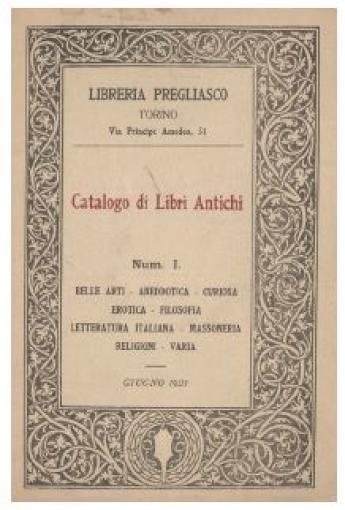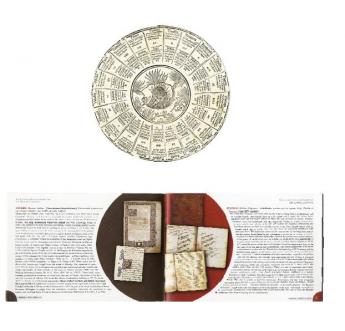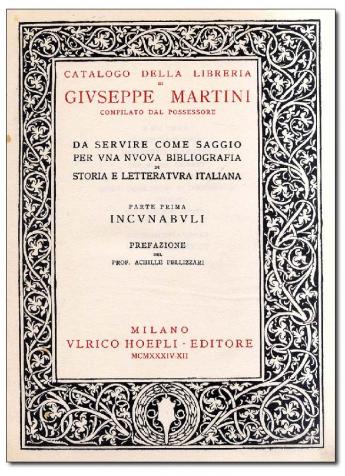Associazione Librai Antiquari d'Italia Pregliasco Libreria Antiquaria di Umberto Pregliasco
The times they are a-changin' in the rare book trade

By Umberto Pregliasco
The line it is drawn
the curse it is cast
the slow one now
will later be fast
as the present now
will later be past
the order is rapidly fadin'.
And the first one now
will later be last
for the times they are a-changin'.
Robert A. Zimmerman
Exactly one year ago, the President of ILAB, Norbert Donhofer, came to Lucca in order to meet qualified scholars and bibliophiles gathered at the Biblioteca Statale for a conference on the life, work and collections of Giuseppe Martini (1870-1944), the most important Italian antiquarian bookseller of his day. Martini, a contemporary of Leo S. Olschki and Ulrico Hoepli, was called by Mario Armanni, the later director of the Libreria Hoepli, “l’homo bibliographicus”.
Norbert Donhofer’s presence, just after his meeting in Naples with the prosecutors of the Girolamini affair, formed another demonstration of how ILAB supported the Antiquarian Booksellers’ Association of Italy (ALAI) during the last five years, which have been the most difficult in the living memory for the Italian trade. Because of the Girolamini scandal and of the new laws concerning Italian Heritage Protection - which currently makes it impossible to legally export any book published before 1965 - Italian booksellers are heavily penalized in competition with their foreign colleagues. This is a considerable understatement!
The successful ILAB Congress and Book Fair I organised in Bologna in 2010, when I served as the President of ALAI, seems light-years away from the current situation facing the ILAB Committee, to which I was elected in 2012. The “times are a changing”: from the Presidents Meeting held in Siena in 2013 by former ALAI President Fabrizio Govi to the 2015 Committee Meeting that ILAB suddenly moved from New York to Milan. Why? For the purpose of holding a workshop on Italian Heritage Protection.
So, I would very much like to reciprocate the support ILAB gave to the Italian trade. Moved by this conference in Lucca, I had the chance of dealing with some incunabula belonging to Martini, whose library is considered one of the richest private collections of Italian literature in the world. Reconsidering them one year after Norbert’s presentation at Lucca, invites me to consider how our profession has been changing. As there has been enough talking of stolen books, forgeries, laws and export licenses, I would like to reflect on the evolution of the booksellers’ job along the 20th century.
In the 19th century a bookseller rarely sold a book, even an important one, with a bibliographic description. As illustrated on the right, at the beginning of his career Martini started quoting the bibliographic records directly on the flyleaves of incunabula in pencil as well as in pen - a practice which would now cause nightmares for booksellers and librarians. Later, he would glue (!) cards with his longer descriptions to the flyleaves. This became the custom at the time and remained so until about 35 years ago.
Norbert and I are old enough to remember when the booksellers started to provide books with typewritten descriptions. When both of us began in the trade, we used to type on cards for the printers of our first catalogues, underlining in red or blue pencil, just as did Martini, what we intended to be printed in bold or italic. The catalogues were composed with a linotype machine: by pressing down on the keys of a large keyboard, the compositor used to typeset the text in lines of metal ready for the press.
I remember well when I had to go to the printer to check the proofs for correction: as the compositor had to replace the entire line of a page to correct a single letter, yet further mistakes were common, so I preferred to be present. Not to mention the complex process for reproducing illustrations or bindings in the catalogue: we used metal-plates not so different from the ones that Aldus employed in his Poliphilo.
So, when Norbert and I began, it was indeed a very different world: computer, fax, scanner did not exist, and the internet? Inconceivable! These colour-coded cards were archived as permanent records by the bookseller. With the advent of the computer, these records were transferred to files, could be enriched over time and, carefully adapted, could be used for multiple copies of the same title. In the early ‘80s linotype was replaced by offset lithography printing, and later by computer typesetting and digitalized images.
With the arrival of the computer, the descriptions by the booksellers became more comprehensive and elegant. But there was still lacking the most recent step in technology which has revolutionized our work as well as that of collectors: the sharing of information through the Internet, which has allowed us to form a huge archive - updated continuously - of millions of description of books on the market and of even more books in libraries, complete with collations.
While until ten years ago a few professionals had the tools for verifying the completeness and rarity of a book, now buyers are easily able to check the accuracy of a description. In addition, the on-line offer of a great number of titles has undoubtedly produced greater transparency than in the past: if the various search engines locate only one or two copies of a book, its rarity is immediately confirmed. It was a radical change for bibliographic work.
The paradox is that although the tools have made work easier, there is more work to be done. This has delayed the production of catalogues, and the desire to produce an accurate and elegant catalogue. The one benefit to booksellers has remained unchanged: their pleasure in studying and understanding the books with which they will someday part.
Giuseppe Martini, whom Norbert celebrated one year ago, had among his many merits spreading his erudition and appreciation ̶ in addition to his commercial activity. Achille Pellizari, author of the catalogue published by Martini-Hoepli, once wrote that Martini “had memories of bibliophiles he had never met, once writing a six-pages entry for a manuscript in a sales catalogue which was not for sale!”
Much has changed in little more than a century of bibliophily. But what really matters remains unchanged: the task of the bookseller is also to disseminate culture by thorough study of the work, accurate description, and the precise condition of the copy - all of which transcend commerce. Just as Martini did, a dealer should even now stimulate the curiosity of collectors, encourage bibliographical research, the conservation of cultural heritage, and the re-evaluation of what was not well known yet or has already been forgotten.
An accurate catalogue of an antiquarian bookseller is a formidable instrument of culture handed down to posterity. “When a writer dies, he embodies the books he has written” Borges declared. Paraphrasing this significant quotation, we could say that a rare book dealer will always live in the catalogues he has published. Very few memories might be left of the books that have been purchased and sold, while the collection of his own catalogues is the bookseller’s true spiritual last will, the story of his life and of how he was able “to sell his own soul”, transmitting with every sale his knowledge and passion to bibliophiles.
In 1921 - ten years after he opened his dusty bookshop and while Martini was at the top of his career - my grandfather published Catalogue no. 1, offering for sale four hundred books, among which the most expensive one was an illustrated incunabulum offered for 65 liras. Since then the changing of generations has added innovation and modernity to the methods of the profession.
In 1998 I published A century before the CD-Rom, an original celebration towards the end of the Twentieth Century of the Italian Novecento books printed by skilled craftsmen (even after Martini was already dead). I chose a title that would emphasize the great distance between the traditional printing and digital reading. At the time, who could imagine the arrival of the e-book? Then, we came up with the new idea of a mutual catalogue with our friends at Libreria Philobiblon: The Battle of the Books. The title from Swift, of course. In this, in a spirit of friendly competition, each of us presented a book against another with similar characteristics.
Yet fun and game, between books and new technologies, were the keywords in presenting an interactive and playful “catalogue” which was actually a DVD devoted to Books and Mss of divination or fortune - Fanti, Spirito, Marcolini. As these books were designed to be games, we wanted viewers to “play” them. Many innovative projects have been realized in conjunction with Libreria Philobiblon, long before Filippo Rotundo and I founded PRPH Rare Books in New York. The most ambitious one is Myriobiblon, a series of four substantial volumes devoted to the Renaissance printing of Greek: Lexica, Authors I-II and Liturgical books.
All of these shared projects realized by booksellers from different cities could have not been possible even twenty years ago, without the technological advance in communication. I strongly believe that our job is to foster the passion for the past by keeping pace with the challenging innovations of the future. Giuseppe Martini in his extraordinary journey - From Lucca to New York to Lugano, between 19th and 20th century, the title of the conference - proved, in his day, even without the technological supports we have now enjoyed, a great and innovative bookseller.
I believe that a good catalogue can also be considered a small consolation for the bookseller himself: as I often say: “that peculiar copy of a book, with its defects, waterstains, signatures, will remain a little bit mine forever, even after I have sold it to a client”. Achille Pellizzari describes a similar feeling: “What more could Martini have done to say goodbye to these friends and companions in life? And this is the book of memories: all that remains of so much love, so many sacrifices, in the empty house”. He wrote this at the very end of the preface to the catalogue of 1954, on the tenth anniversary of Martini’s death.
Besides the economic incentive, I cannot help but consider the intellectual enrichment involved in the book dealing as a truly gratifying reward. When I was a young boy I had the chance to meet the founder of ILAB, and a great bookseller, Menno Hertzberger. For almost 30 years I have been sharing with Norbert Donhofer and other Presidents of ILAB experiences about books, ILAB, and wine: though the times are a changin’, I believe that the exchange of views with him and some fellow book dealers from all over the world remains an irreplaceable resource in our unique profession.
***
Click below to download the fully illustrated version. Umberto Pregliasco is a Past President of the Antiquarian Booksellers' Association of Italy (ALAI) and an ILAB Committee Member. Published here by permission of the author. Pictures: Umberto Pregliasco.




